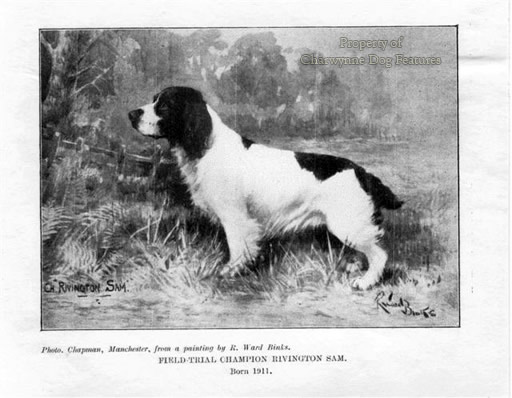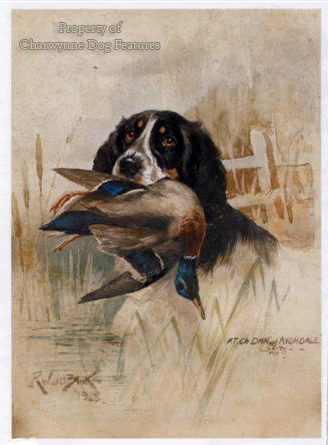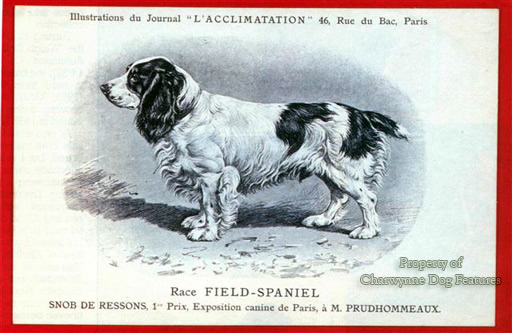776 DIGGING OUT THE MINORS-PRMOTING THE LESSER-KNOWN SPANIEL BREEDS
DIGGING OUT THE MINORS
by David Hancock
 Loss of Minor Breeds
Loss of Minor Breeds
If you glanced at the annual registrations of spaniels with the Kennel Club you would be impressed by the sheer number being bred each year: some 38,000. But if you then take away the totals for two particular breeds, the English Springer and the Cocker, you would be left with less than a thousand registrations from all the other sporting spaniel breeds. Of four of the land spaniel breeds, the Welsh Springer can reach around 500 each year, but the remaining three give cause for serious concern. For the Clumber, with only around 200 registrations a year, the outlook is worrying. For the Sussex, with just over 50, and the Field, with around 75, the outlook is dire. These two old British gundog breeds deserve our support. In 1908 over 280 Field Spaniels were registered with the KC, against less than 50 English Springers; the Sussex Spaniel was a dying breed even then. Just after the Great War, the Field Spaniel was outcrossed to the English Springer Spaniel, led by Mr RR Kelland with his Black Prince and Mr G Mortimer-Smith’s renowned Wribbenhall strain. In due course, the Field Spaniel Society, formed in 1923, was able to organise field trials where Major Beaumont’s Strouds kennel became highly successful.
In 1945, there were only 4 Field Spaniel bitches left to breed from and they were all by the same dog. In that year too, there were only 6 purebred Sussex Spaniels left, all owned by the same breeder and all closely related. In 1964 the Clumber Spaniel Thornville Snowstorm was mated to the Sussex Spaniel Weiden Jhansi of Patmyn. In 1978 there was at least one Sussex Spaniel owner still breeding this line. If such a course of action has actually strengthened the breed’s gene pool and breed type has survived I see little to complain about in this sort of breeding diversion. Nowadays in the shooting field the English Springers and the Cockers rule the roost. But I see so much to admire in the handsome springer from Wales, the distinctive spaniel from Sussex and the fussless Fields.
The Field Spaniel may well be the truest model for all our modern English breeds of land spaniels. This breed is the sturdy active contemporary version of the old sporting spaniel. To avoid confusion between Field (the name of the breed) and field spaniels (spaniels used in the field) it might have been preferable to have named this breed ‘The English Land Spaniel’. The present title is rather a nondescript name for a breed that is anything but nondescript. Today’s lively, well-proportioned, fine looking breed certainly merits a suitably distinctive name. Field Spaniels have made enormous strides in physical conformation since the antics of their fanciers of the 1890-1900 period, the peak of the ‘bassetized era’, in which a needlessly low stature was favoured. Then, exhibitors could be seen at shows actually aiming to impress the breed judge with the sheer length of their entry, to claim on one occasion, that Rother Queen was half an inch longer in the back than Undeniable, as a point of merit in a working gundog! Sometimes the greatest threat to a breed’s well-being comes from its own fanciers.
The so-called ‘Chocolate Drop’ spaniels of Richard and Jenny Mace have their admirers in the field. Originating in a cross between a working Cocker and a Sussex Spaniel, they are seriously effective working spaniels, strong, biddable and determined. Over the last 15 years, over 100 of these ‘chocdrops’ have been bred, always from working stock that had been eye and hip-tested. The aim was always to produce working spaniels, not a designer dog or to make the Sussex breed less pure. I can see nothing but merit in that. In the last ten years, pedigree Sussex Spaniels have only been registered in these numbers: 89, 98, 70, 82, 68, 79, 77, 74, 61 and most recently 56. What would you want? A dying breed prized for its unique rolling gait, characteristic frown and waistline-free torso? Or a proven worker benefiting from a blend of blood? Gundog breeds which lose their working role soon lose their working ability and then the patronage of the shooting fraternity. There is worry too over the scale of inbreeding, some Sussex Spaniels having a Coefficient of Inbreeding of over 25%, the highest of the gundog breeds. I see much to admire in the Sussex Spaniel and long for a wider employment for them in the field. I was very taken with a Sussex Spaniel at a show a couple of years back: Jubilwell Thor, a very sound specimen and good breeding material. I was also impressed by the entry at Crufts in 2012, an encouraging collection of admirable spaniels.
Breed under Threat
At the third International Clumber Spaniel Symposium in Sweden in 1993, Dr Sungren, a leading Swedish geneticist stated that 'the breed may not survive more than thirty years' and recommended an early outcross. In one of the weekly dog papers in December last year a leading Clumber Spaniel breeder rather patronisingly described the working Clumbers as 'the Springer type dogs belonging to those who solely use them for working'. I doubt whether the working Clumbers will need an early outcross, the ones I see are eminently sound dogs. But the dogs I see in the show rings, even at Crufts, have faults, inbuilt faults, which any gundog breed could well do without. For me, the so-called 'Springer type dogs belonging to those who solely use them for working' are more like the original Clumbers than any dog I see in the show ring masquerading as a sporting spaniel. Who needs an 80lb spaniel?
Working Prowess
But how are the despised 'Springer types' doing on the working side? Dogs like James Darley's Sedgehurst Maxim Venaticus, John Zurich's Sedgehurst Tormentum, David Wood's Julchris Bob, Mrs S Ruffles's Lliojaschar Digby and Bill Cadwell's Greencourt Mistic Meg of Jubiwell have all won trials. These dogs are usually the lighter type, the type promoted by James Farrow the great pioneer breeder of Clumbers. He found that the original Clumbers were around 25 to 30lbs, less than half the weight of today's show ring specimens. His information came from the Duke of Newcastle's kennelman. Why breed away from a breed's history? Farrow also records how the showing of haw in the dogs' eyes was discouraged at the turn of the century but show breeders over-ruled those who worked their dogs and the toleration of haw in the eye remained. Incidentally, he linked their origin with the Blenheim Spaniel, in a lemon and white coat. 
Need for Support
With the Kennel Club's campaign for healthier dogs underway, the desire for massive heads, sunken eyes and eyes showing haw is likely to be curtailed, and not before time. It shouldn't take an outside body to instruct breed clubs how to breed healthier dogs but clearly the need is there and not just in this breed. I am full of admiration for working Clumber fanciers like James Darley and the Zurichs. This is not a popular breed, with 146 registered with the KC in 1906, 143 eighty years later and, encouragingly, 223 in 2007. The triumph of the English Springers in the field, and the sustained popularity of the Cocker shows, what can be attained by unexaggerated spaniels. With the Fields and Sussex Spaniels also struggling (only just over 60 registered for each of these breeds in 2007) the minor spaniels need support.
Of course, in the gundog world, there are plenty of fine working dogs: Cockers, English Springers, Irish Setters, Pointers, Labradors and, increasingly, the 'hunt, point and retrieve' breeds. But the minor breeds of spaniel are part of our national sporting heritage, with genetic importance too. Much as I admire a top-class field trial Labrador or Cocker, I just as much want to see the separate idiosyncrasies of the less popular breeds conserved. A crossbred spaniel that can really work is a much more valuable animal to me than any statuesque show-ring poseur with no working capability. As Wilson Stephens, doyen of 20th century gundog writers, once drily wrote: "They didn't send male models to recapture the Falklands!" Those involved in the future of our minor breeds of spaniel have much to think about.